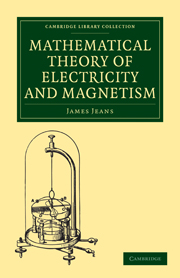Book contents
- Frontmatter
- Preface
- Contents
- Introduction
- ELECTROSTATICS AND CURRENT ELECTRICITY
- CHAP. I Physical Principles
- CHAP. II The Electrostatic Field of Force
- CHAP. III Conductors and Condensers
- CHAP. IV Systems of Conductors
- CHAP. V Dielectrics and Inductive Capacity
- CHAP. VI The State of the Medium in the Electrostatic Field
- CHAP. VII General Analytical Theorems
- CHAP. VIII Methods for the Solution of Special Problems
- CHAP. IX Steady Currents in Linear Conductors
- CHAP. X Steady Currents in Continuous Media
- MAGNETISM
- ELECTROMAGNETISM
- INDEX
CHAP. II - The Electrostatic Field of Force
from ELECTROSTATICS AND CURRENT ELECTRICITY
Published online by Cambridge University Press: 05 August 2011
- Frontmatter
- Preface
- Contents
- Introduction
- ELECTROSTATICS AND CURRENT ELECTRICITY
- CHAP. I Physical Principles
- CHAP. II The Electrostatic Field of Force
- CHAP. III Conductors and Condensers
- CHAP. IV Systems of Conductors
- CHAP. V Dielectrics and Inductive Capacity
- CHAP. VI The State of the Medium in the Electrostatic Field
- CHAP. VII General Analytical Theorems
- CHAP. VIII Methods for the Solution of Special Problems
- CHAP. IX Steady Currents in Linear Conductors
- CHAP. X Steady Currents in Continuous Media
- MAGNETISM
- ELECTROMAGNETISM
- INDEX
Summary
CONCEPTIONS USED IN THE SURVEY OF A FIELD OF FORCE
The Intensity at a point.
The space in the neighbourhood of charges of electricity, considered with reference to the electric phenomena occurring in this space, is spoken of as the electric field.
A new charge of electricity, placed at any point 0 in an electric field, will experience attractions or repulsions from all the charges in the field. The introduction of a new charge will in general disturb the arrangement of the charges on all the conductors in the field by a process of induction. If, however, the new charge is supposed to be infinitesimal, the effects of induction will be negligible, so that the forces acting on the new charge may be supposed to arise from the charges of the original field.
Let us suppose that we introduce an infinitesimal charge ∈ on an infinitely small conductor. Any charge e1, in the field at a distance r1 from the point 0 will repel the charge with a force ∈e/r12. The charge ∈ will experience a similar repulsion from every charge in the field, so that each repulsion will be proportional to ∈.
The resultant of these forces, obtained by the usual rules for the composition of forces, will be a force proportional to ∈–say a force R∈ in some direction OP. We define the electric intensity at 0 to be a force of which the magnitude is R, and the direction is OP.
- Type
- Chapter
- Information
- Mathematical Theory of Electricity and Magnetism , pp. 24 - 65Publisher: Cambridge University PressPrint publication year: 2009First published in: 1908

